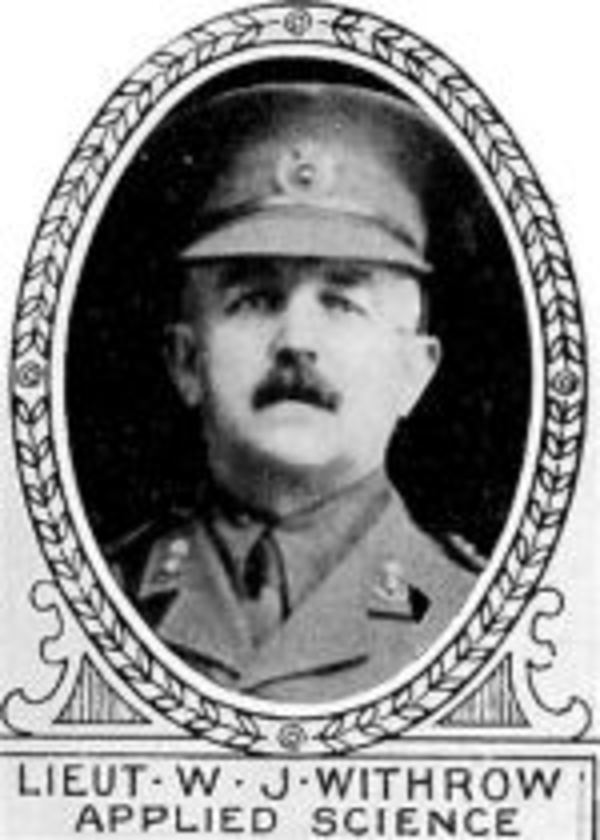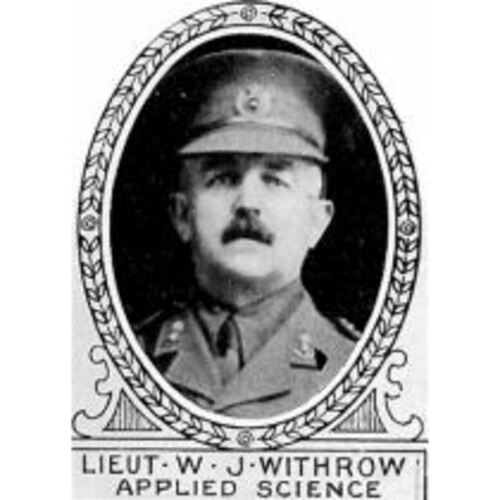
Source: Link
WITHROW, WILLIAM JAMES, engineer, civil servant, militiaman, and officer; b. 28 Oct. 1868 in Hamilton, Ont., one of the two sons of William Henry Withrow* and Sarah Anne Smith; nephew of John Jacob Withrow*; m. first 7 Sept. 1896 Edith Mary Burns in Toronto, and they had one son; m. secondly 16 June 1908 Margaret Eleanor Guinevere MacCarthy in Ottawa, and they had two daughters; d. 4 May 1917 in Mont-Saint-Eloi, France.
Little is known about William James Withrow’s childhood. He attended the Model Grammar School and Collegiate Institute in Toronto and graduated with a ba in engineering from the University of Toronto in 1890. By 1893 he had become a draftsman for Fetherstonhaugh and Company, patent lawyers and engineers, while continuing to live with his parents on Jarvis Street. Not unusually for a member of the middle class, Withrow had found time to serve in the ranks of the 2nd Battalion of Rifles (Queen’s Own Rifles of Canada), one of Toronto’s most fashionable militia units, for three years following 1887. He worked with Fetherstonhaugh until 1895 or later; at the time of his first marriage he was a patent solicitor in Montreal. By 1899 he was back in Toronto, as an engineer/designer for the Luxfer Prism Company Limited.
Sometime after 1901, when his wife died, Withrow and his young son moved to Ottawa, and by the outbreak of World War I he was a patent examiner in the Department of Agriculture. In 1914 he joined the 3rd (Ottawa) Field Engineer Company, a militia unit that did not go overseas; once again, it seems, he served in the ranks. On 4 Dec. 1915 Withrow was taken on strength, with the rank of lieutenant, by the 2nd Pioneer Battalion of the Canadian Expeditionary Force. By this time he had remarried and was the father of three children; his son Wilfrid Forbes, who served in France with the 21st Battalion, would be wounded and receive the Military Medal just before his father’s death.
The pioneer battalions were a recent innovation forced upon the high command by the demands of trench warfare. The extensive defensive positions that ran from Switzerland to the English Channel required thousands of soldiers to maintain them and thousands more were needed if further defences were to be dug in. Pioneers, basically a cross between engineers and infantry, would take responsibility for maintenance and new constructions and accepted only skilled tradesmen. After embarking for France on 12 March 1916, Withrow in time became the battalion’s Lewis machine-gun officer, perhaps because he had undergone a course in musketry in Canada. As one of three officers in the specialty section (the others being responsible for scouting and bombing respectively), he was to ensure that the Lewis gunners were properly trained and provided with the necessary weapons and equipment. The activities of Withrow and his section at the front are unclear, but most likely they occupied defensive positions while the rest of the battalion and its accompanying infantry work parties dug and wired trenches. During the battle for the craters at Saint-Eloi (Sint-Elooi), Belgium, in April, the 2nd Pioneer Battalion prepared captured German trenches for use by Canadian troops.
On 9 Jan. 1917 Withrow went to Corps headquarters, taking command of the Topographical Section. There he oversaw the production of large-scale speciality maps, such as plans of redoubts, batteries, and other defensive positions or units. Reproduction equipment was rudimentary and many maps would have been issued in manuscript form. He continued in command through the battle of Vimy Ridge in April and was thus responsible for many of the specialized sketches and drawings produced for that operation.
In early May Withrow was appointed quartermaster of the 2nd Pioneer Battalion, but while watching a baseball game on the 4th, he fell from his horse and died. An autopsy concluded that he had succumbed to “Acute Dilatation due to overexertion and excessive heat,” or heart failure. Though Withrow had been considered physically fit at the age of 48, the post-mortem revealed much fatty tissue in the right ventricle; however, the link had not yet been made between a fatty diet and heart disease.
William James Withrow never reached the upper echelons of the public service or the militia. His significance is not in his rank but in what he exemplifies: those who had entered the professions at the end of the 19th century and whose lives took an entirely different course as a result of World War I.
AO, RG 80-5-0-241, no.15438; RG 80-5-0-374, no.5907; RG 80-8-0-249, no.1303. NA, RG 9, III, 4454, folder 6, file 6; 4709, folder 10, file 5; 5010; RG 150, Acc. 1992–93/166. Ottawa Citizen, 11 May 1917. Can., Dept. of Militia and Defence, Canadian Expeditionary Force: nominal rolls (13v., Ottawa, 1915–18), 13, 2nd Pioneer Battalion. Directory, Toronto, 1892–1903. J. S. Murray, “British-Canadian military cartography on the Western Front, 1914–1918,” Archivaria (Ottawa), no.26 (summer 1988): 52–65. Univ. of Toronto, University of Toronto roll of service, 1914–1918 (Toronto, 1921).
Bibliography for the revised version:
FamilySearch, “Canada, Ontario marriages, 1869–1927,” Wilfred Forbes Withrow and Evelyn Gertrude Withrow, 12 March 1924: familysearch.org/ark:/61903/1:1:FMFZ-D2Y (consulted 3 May 2023). Library and Arch. Can., “Census of Canada, 1901,” Ont., dist. York East (129), subdist. East Toronto (Village) (A): 15: www.bac-lac.gc.ca/eng/census/1901/Pages/about-census.aspx (consulted 3 May 2023); “Personnel records of the First World War,” Wilfred Forbes Withrow: central.bac-lac.gc.ca/.redirect?app=pffww&id=319784&lang=eng (consulted 3 May 2023). Ottawa Citizen, 12 May 1917.
Cite This Article
William Rawling, “WITHROW, WILLIAM JAMES,” in Dictionary of Canadian Biography, vol. 14, University of Toronto/Université Laval, 2003–, accessed January 8, 2026, https://www.biographi.ca/en/bio/withrow_william_james_14E.html.
The citation above shows the format for footnotes and endnotes according to the Chicago manual of style (16th edition). Information to be used in other citation formats:
| Permalink: | https://www.biographi.ca/en/bio/withrow_william_james_14E.html |
| Author of Article: | William Rawling |
| Title of Article: | WITHROW, WILLIAM JAMES |
| Publication Name: | Dictionary of Canadian Biography, vol. 14 |
| Publisher: | University of Toronto/Université Laval |
| Year of publication: | 1998 |
| Year of revision: | 2023 |
| Access Date: | January 8, 2026 |



